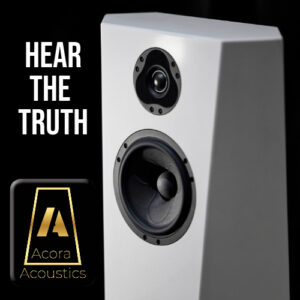Treehaus AudioLab is a high-end audio company that specializes in handcrafted audio equipment, particularly loudspeakers. Their speakers are known for their use of field-coil drivers, which are a type of driver that is known for its exceptional sound quality but is also very rare and expensive. They also produce amplifiers and preamplifiers.
Words and Photography by Grover Neville

“Everything is sculpture. Any material, any idea without hindrance born into space, I consider sculpture.” – Isamu Noguchi
Seldom does a single artist alter my perception of a fundamental law of nature as much as Isamu Noguchi. The sculptor and designer was fascinated with space and our relationship with it, yet he himself existed in a cultural third space: neither fully Japanese nor totally Anglo-American, supported but never fully accepted by his famous father, and an iconoclast in the world of art and design with a style all his own. It’s hard not to imagine a great deal of loneliness in his life.
Yet what we find beneath the contradictions is joy realized in the renegotiation of space. Noguchi spent six months in a Japanese-American internment camp during World War II, but did so voluntarily. He was called talentless by Borglum, the sculptor behind Mt. Rushmore, and almost went on to become a doctor before falling into his own distinct path in the art world. And yet this supposed talentless failure carved his art in negatives and natural shapes across some of the most iconic public spaces in the world.
Noguchi himself, in 1988, the year of his death, mused: “For one with a background like myself, the question of identity is very uncertain. And I think it’s only in art that it was ever possible for me to find any identity at all.” Heady, aspirational stuff for any artist, myself very much humbly included. To exist between spaces and also carve his vision from them in such elegant shapes is perhaps a perfect analogy for Noguchi’s own Japanese-American identity.
The inspirations and parallels between Treehaus Audiolab and Noguchi, I think, are fairly clear—a marriage of structural and organic shapes, like sculptures carved into the space where speakers ought to be. But I believe these similarities are just the bare surface of a more meaningful throughline. If Noguchi’s concept of harmony between positive and negative space influenced my perception of our fundamental relationship with space, what would it mean to renegotiate our fundamental relationship with auditory space and time?

“The essence of sculpture is for me the perception of space, the continuum of our existence.” – Isamu Noguchi
Speakers are an unusual creation, perhaps one of the most unusual creations of the modern era. They are amongst the simplest devices—when compared to a computer or car, for example—and yet one of the most mystifying. They are, in essence, time machines, carving out aural space or time within the space of our day. Like a photo negative, the Treehaus speakers seem to be cut from the space around them, partially due to their open baffle nature and live edges, and partially due to the acoustical sculpture they present.
Those handmade field-coil drivers are run full-range and capture a certain tonal and harmonic magic I’ve only heard well-implemented full-ranges and field-coils do—a kind of immediacy and naturalness of harmonic structure that tickles my brain in a very pleasing way. Unlike most of those who’ve spent time pursuing ‘vintage’ audio, however, Treehaus AudioLabs is a different animal because the pursuit is not one beholden to nostalgia but a search for an undeniable something that the best methods of the past provide—that thing that gives us a thrill that allows us to more than the present would appear to offer.
This is not idle speculation either; speak with Rich Pinto, the mind beyond Treehaus’ loudspeakers, and you’ll quickly realize he’s an audiophile’s audiophile with a keen ear and high standards. This manifests most obviously in the powered and DSP-driven bass module and Fostex bullet super-tweeter that come alongside that romantic-sounding handmade field-coil. Art, meet science.
In my conversations with him, I’ve also realized he values the pursuit of music in time. I’ve lately been reflecting on the fact that music is one of the few media forms we cannot accelerate our experience of. The written word can be skimmed, movies and videos scrubbed through, or watched at faster speeds, but music simply does not work as intended unless it is experienced in its own time. This, then, can be thought of as auditory or temporal space, and as we know, space can be empty or filled. It seems to me that Treehaus is very much about filling that temporal space with things that are deeply considered.

“We are a landscape of all that we have seen.” – Isamu Noguchi
This irresistible magic from years past that led to Treehaus searching for inspiration from Sakuma-style circuits, to designing Noguchi-inspired speakers, to deep explorations of Japanese transformers and bass DSP is all the result of one simple truth: sometimes the human touch is just better. No, perhaps not better measuring, or more precise, or any of those other analytical methodologies we use so often in the theater of the mind, but better for the subjective delight it brings.
Compare, if you will, modern Deutsche Gramophone digital recordings—spectacularly clear, free of artifacts, quiet, clean, and marvelously open—to say, the recordings of Reiner with the Chicago Symphony Orchestra by Living Stereo and RCA; Less wide, less immediate, more naturally compressed by the tube electronics and tape used, and yet, there is a magic that pervades these recordings that is transfixing. This is the essence of what Treehaus is looking for, and they just happen to be looking for it beyond the boundaries of carbon fiber, milled aluminum, and graphene.
Instead, they looked to the beautiful and timeless design work of the 1950s and 1960s from the likes of Eames and Nakashima, the early Klangfilm and Western Electric loudspeaker efforts, Telefunken, and later, Japanese transformer and tube experiments, and from this historical perspective, they synthesized and distilled each of these elements to their core pieces. Of course, there is a heavy influence from Japanese audio and design, but also, and equally, an American modernist touch.
This marriage of past and present—perhaps mirroring the duality of Noguchi and his art—in Treehaus’ work celebrates what is seldom done: a study of how past and present meet. As I mentioned in my review of the SW1X DACIV, the very best experiences of music help us to mark time with memory. If the suspension of disbelief is key to immersion in cinema, then the suspension of time or our awareness of time is what the best musical experiences do. And this is where the Treehaus AudioLab products come into play.

“It is weight that gives meaning to weightlessness.” – Isamu Noguchi
When listening to either the electronics or the loudspeakers from this idiosyncratic brand, I find myself considering another duality: the difference between Hi-Fi and Audiophilia. Of course, I’m practicing a bit of semantics, but I think there’s an important distinction between the listener who is pursuing absolute bandwidth fidelity and the lowest possible distortion and the listener who is pursuing listening pleasure. The former is grounded in what math and tools of analysis can tell us about the experience, and the latter is purely based on what we feel when we enter that concentrated listening space.
I won’t advocate for either of these being superior approaches, and in truth, any endeavor requires a bit of both. Treehaus undoubtedly aims for the listener who leans subjectively but has that analytical itch inside them, or at least gives them the option to sate it. The field-coil driver has several settings that offer various sounds, and the DSP low end is, of course, endlessly adjustable to taste. The pursuit of this art is just a little personal, a little unique to each of us.
If any idea born without hindrance into a space is sculpture, then one can see the capability for personalization and adjustment, as helping to birth without hindrance Treehaus products into the auditory space of our rooms. The results are a merging of the old and the very new. The richness of a wideband field-coil and bullet supertweeter with the dynamics and power of corrected and separately amplified bass modules is… well, it’s not a sound profile I’ve really heard before. One might even call it iconoclastic.
At its very best, this approach captures more than a vintage magic or nostalgia; rather, it captures that magic of things that are simply very good. In a tech-obsessed world that places high value on innovation and often disregards the ideas of the past, The Canon, or at least a respectful eye towards the shoulders we stand on, often enriches our understanding in ways we least expect. While we continue to be clever, we have also been clever for a very long time. In this light, the pressure of total invention can be seen more as a continuum, and our contributions more as building on the gestalt.

“Art should become as one with its surroundings.” – Isamu Noguchi
The space between wonder and existential dread is defined by scale. Zoom out a little from the quotidien, and you’ll marvel at our progression from caves to canvases to cars, but zoom out too much and the crushing enormity of space and time starts to wash away any sense of individual identity. The key is expanding to fill the right amount of space, and like Noguchi’s abstract sculptures, sometimes we see it most clearly by subtracting and repositioning.
In this way, the subtraction of various elements that Treehaus performs—the subtraction of a cabinet, excepting the baffle, and the subtraction of a more complex crossover and modern materials—better highlights the additions they make to a space. Sculptural, intentional, not an object in pursuit of a purpose but a purpose realized by an object. The sensation of weightlessness that accompanies the thrill of life’s highs, delivered and given shape by its avatar of wood, steel, and wire.
Treehaus is a synthesis of all of these elements, examined carefully and presented for those who understand and appreciate what it means to participate in a celebration of the history of art and science in reproduction. The space they occupy in a room tells a story that encompasses the history of both sculpture and audio reproduction and yet exceeds the dualities inherent in both: if a speaker can be elegant and functional, both imposing and easy to live with, both Hi-Fi and Audiophile, then Treehaus accomplishes this, and in marrying these dualities, becomes as one with its surroundings.


































